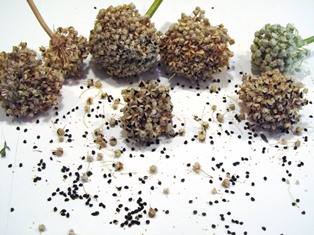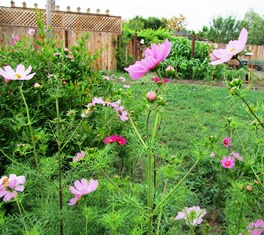Gather Dry Seedpods Now for Next Year’s Garden
When I notice the seedpods of my favorite flowers beginning to dry, I start carrying a felt-tip pen and paper bags around the garden for collection and labeling. Also when my favorite varieties of heirloom pumpkins and squash are ripe, I’ll cut open the plants, collect the seeds, clean and dry them, and store in paper envelopes or glass jars.
Throughout the summer, I do the same with the best specimens of my heritage tomatoes and beans.
Gather the seeds of your favorite plants when the flowering (or production) is over and the pods are drying. On my patio harvest table, a long metal table with a tiled top, I place giant sunflower heads to finish drying. I then save some seed for replanting, the rest for eating. But I always share some with the squirrels and birds.
There are multiple bowls, buckets, and glass jars on the table, too. These hold the papery pods of lobelia’s tiny seeds and the onion seed heads that only need a good shaking onto a paper towel to remove the tiny black seeds. I’ve got containers of cosmos and also zinnia seeds, too, collected during early morning walks around my farmette.
When you plant open-pollinated heritage plants, it’s easy to keep a steady supply of seeds for next year’s garden. You can get an early jump on spring by sowing these seeds into seed flats or wait until the danger of frost has passed to sow them directly into prepared beds. The process of collecting, saving, and replanting seeds is how our ancestors did it, and it still works.
* * *
If you enjoy reading about farmette topics (including gardening, beekeeping, and delicious recipes), check out my cozy mysteries A BEELINE TO MURDER and also THE MURDER OF A QUEEN BEE in the Henny Penny Farmette series (from Kensington Publishing). These novels are chocked full of recipes, farming tips, and sayings as well as a charming cozy mystery.
The books are available through online retailers such as Amazon, Barnes & Noble, Kobo Books, and Walmart as well as from traditional bookstores everywhere.
See, http://tinyurl.com/hxy3s8q
This debut novel launched the Henny Penny Farmette series of mysteries and sold out its first press run. It’s now available in mass market paperback and other formats.
See, http://tinyurl.com/h4kou4g
Release date is September 27 for this, the second cozy mystery in the Henny Penny Farmette series. It’s available free on Net Galley (netgalley.com) for readers, bloggers, and other professionals who write reviews.
Plants to Attract Hummingbirds
It’s hummingbird mating season. We’re seeing iridescent males with ruby throats engaged in amazing aerobatic flight patterns to attract females. To draw these birds to our garden, we’ve put in plants they are known to seek out.
To attract them, we’ve planted flowers with brightly colored blooms such as purple-spired agastache, red blooming wild columbine, cosmos (pink, white, and red) scarlet ipomopsis (also known as the hummingbird plant), larkspur (Giant Imperial has colors ranging from pink, dark blue, light blue, carmine, rose, salmon, and white), lobelia (various shades), poppies, and salvia (Fairy Queen has a brilliant purple color).
This morning as I was inspecting the peach tree, a male with a ruby throat perched on a branch right above the branch tip I was holding. I love seeing these little birds who are voracious feeders, consuming daily nearly half their body weight in nectar and feeding from the sugar-water feeders I’ve hung near my kitchen garden window six to eight times an hour.
Many of the above-mentioned plants also attract butterflies. Sow a few of each of these seeds and you’ll have visitors to your garden throughout the spring and summer months (or during each plant’s blooming season).
 Facebook
Facebook Goodreads
Goodreads LinkedIn
LinkedIn Meera Lester
Meera Lester Twitter
Twitter










